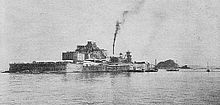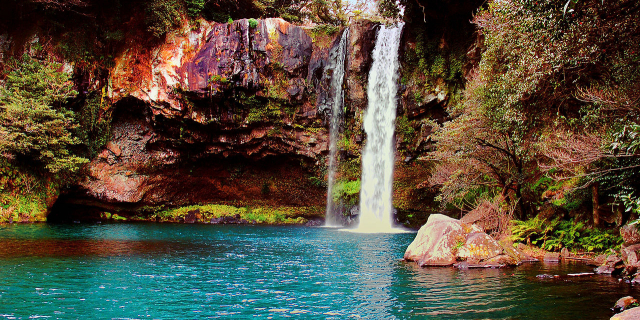端島 (長崎県)
( Hashima Island )
Hashima Island (端島, or simply Hashima, as -shima is a Japanese suffix for 'island'), commonly called Gunkanjima (軍艦島, meaning 'Battleship Island'), is a tiny abandoned island off Nagasaki, lying about 15 kilometres (8 nautical miles) from the centre of the city. It is one of 505 uninhabited islands in Nagasaki Prefecture. The island's most notable features are its abandoned concrete buildings, undisturbed except by nature, and the surrounding seawall. While the island is a symbol of the rapid industrialization of Japan, it is also a reminder of Japanese war crimes as a site of forced labour prior to and during World War II.
The 6.3-hectare (16-acre) island was known for its undersea coal mines, established in 1887, which operated during the industrialisation of Japan. T...Read more
Hashima Island (端島, or simply Hashima, as -shima is a Japanese suffix for 'island'), commonly called Gunkanjima (軍艦島, meaning 'Battleship Island'), is a tiny abandoned island off Nagasaki, lying about 15 kilometres (8 nautical miles) from the centre of the city. It is one of 505 uninhabited islands in Nagasaki Prefecture. The island's most notable features are its abandoned concrete buildings, undisturbed except by nature, and the surrounding seawall. While the island is a symbol of the rapid industrialization of Japan, it is also a reminder of Japanese war crimes as a site of forced labour prior to and during World War II.
The 6.3-hectare (16-acre) island was known for its undersea coal mines, established in 1887, which operated during the industrialisation of Japan. The island reached a peak population of 5,259 in 1959. In 1974, with the coal reserves nearing depletion, the mine was closed and all of the residents departed soon after, leaving the island effectively abandoned for the following three decades.
Interest in the island re-emerged in the 2000s on account of its undisturbed historic ruins, and it gradually became a tourist attraction. Certain collapsed exterior walls have since been restored, and travel to Hashima was reopened to tourists on 22 April 2009. Increasing interest in the island resulted in an initiative for its protection as a site of industrial heritage.
After much controversy, the island's coal mine was formally approved as a UNESCO World Heritage Site in July 2015, as part of the Sites of Japan's Meiji Industrial Revolution series. Japan and South Korea negotiated a deal to facilitate this, in which Korea would allow Hashima Island to be included, while Japan would cover the history of forced labor on the island. Instead, Japan created a museum denying that forced labor ever occurred on Hashima. In 2021, all other 21 nations on the UNESCO committee agreed that Japan had failed to meet its side of the deal, and asked Japan to acknowledge that forced labor occurred in exhibits on Hashima. As of 2024, Japan has continued to refuse to comply with their request.
 An apartment block on the island, c. 1930
An apartment block on the island, c. 1930 Hand-tinted postcard of Hashima from the Meiji era
Hand-tinted postcard of Hashima from the Meiji era Hashima c. 1930
Hashima c. 1930 View of the island in 2009
View of the island in 2009Coal was first discovered on the island around 1810,[1] and the island was continuously inhabited from 1887 to 1974 as a seabed coal mining facility. Mitsubishi Goshi Kaisha bought the island in 1890 and began extracting coal from undersea mines, while seawalls and land reclamation (which tripled the size of the island[citation needed]) were constructed. Four main mine-shafts (reaching up to a kilometre deep) were built, with one actually connecting it to a neighbouring island. Between 1891 and 1974, around 15.7 million tons of coal were excavated in mines with temperatures of 30 °C and 95% humidity.
In 1916, the company built Japan's first large reinforced concrete building (a 7-floor miner's apartment block),[2] to accommodate their burgeoning ranks of workers. Concrete was specifically used to protect against typhoon destruction. Over the next 55 years, more buildings were constructed, including apartment blocks, a school, kindergarten, hospital, town hall, and a community centre. For entertainment, a clubhouse, cinema, communal bath, swimming pool, rooftop gardens, shops, and a pachinko parlour were built for the miners and their families.
Beginning in 1930s and until the end of World War II, conscripted Korean civilians and Chinese prisoners of war were forced to work under very harsh conditions and brutal treatment at the Mitsubishi facility as forced labourers under Japanese wartime mobilisation policies.[3][4][5][6] During this period, many of those conscripted labourers died on the island due to various dangers, including underground accidents, exhaustion, and malnutrition; 137 died by one estimate;[7] about 1300 by another.[8]
In 1959, the 6.3-hectare (16-acre) island's population reached its peak of 5,259, with a population density of 835 people per hectare (83,500 people/km2, 216,264 people per square mile) for the whole island, or 1,391 per hectare (139,100 people/km2) for the residential district.[9]
As petroleum replaced coal in Japan in the 1960s, coal mines began shutting down across the country, and Hashima's mines were no exception. Mitsubishi officially closed the mine in January 1974, and the island was cleared of inhabitants on 20 April.[10]
Today, its most notable features are the abandoned and still mostly-intact concrete apartment buildings, the surrounding seawall, and its distinctive profile shape. The island has been administered as part of Nagasaki city since the merger with the former town of Takashima in 2005. Travel to Hashima was re-opened on 22 April 2009, after 35 years of closure.[11]



































Add new comment